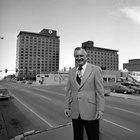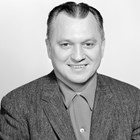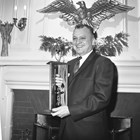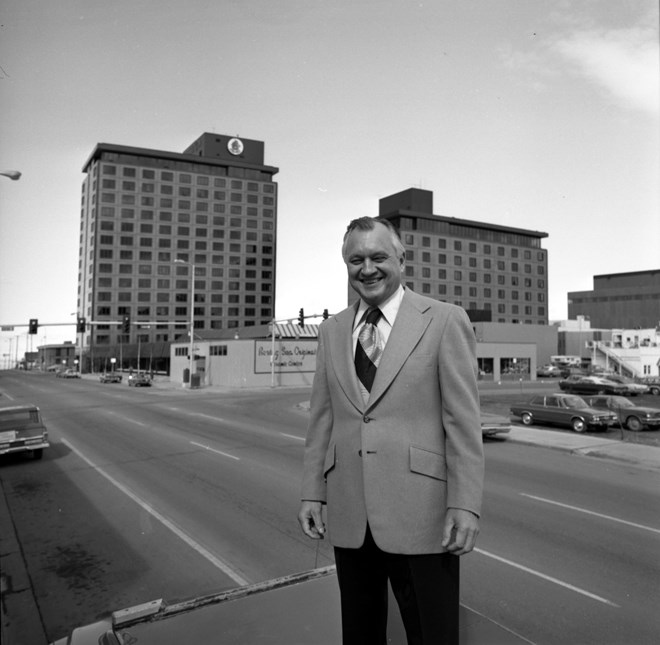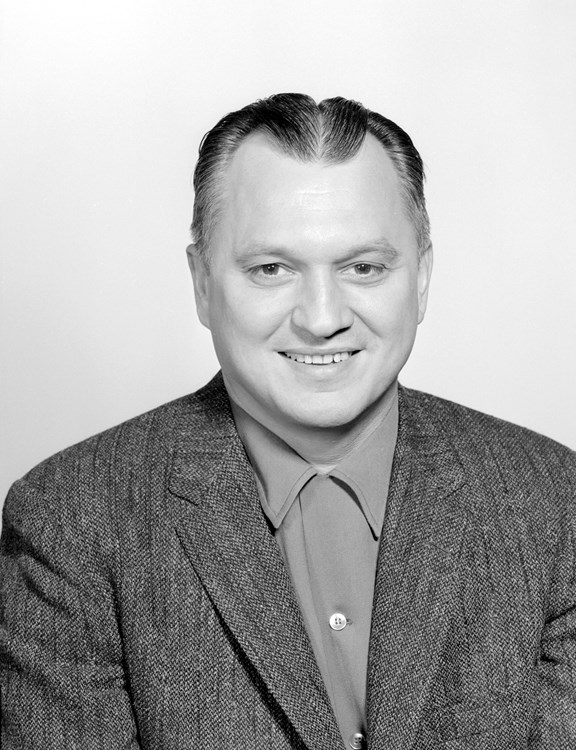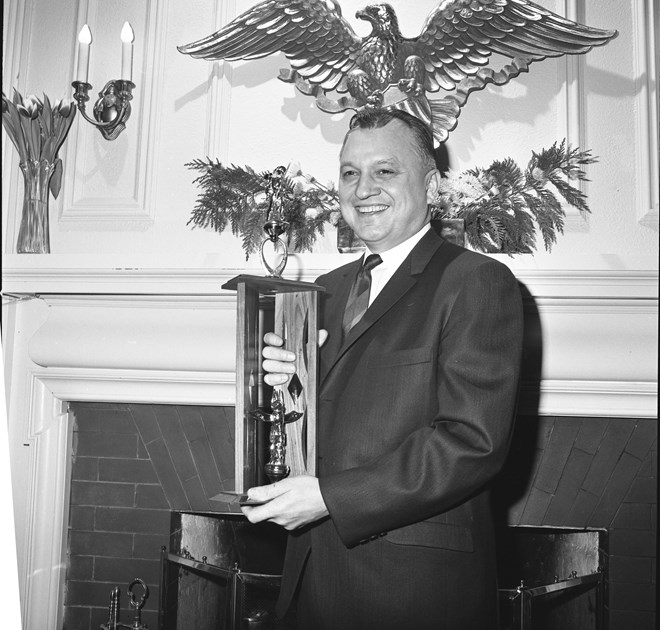Hickel, Walter J. "Wally"
1919 - 2010 | Businessman, Governor of Alaska, and U.S. Secretary of the Interior
Walter J. “Wally” Hickel came to Alaska in 1940 with thirty-seven cents in his pocket and used it as seed money to become a self-made multi-millionaire, businessman, and politician. During Alaska’s post-World War II economic boom, he was one of the Territory’s most successful businessmen, and was heavily involved in real estate development, building residential subdivisions, and constructing and operating shopping centers and hotels. Beginning with the Alaska statehood movement in 1952, he was active in politics and served as the second (1966-1969) and eighth (1990-1994) governor of Alaska. He served as U.S. Secretary of the Interior (1969-1970) under the Richard M. Nixon Administration. After urging President Nixon to give more respect to the views of young people about the Vietnam War, he was fired by Nixon on Thanksgiving Eve 1970. He saw Alaska as having great potential and promoted Alaska’s interests as a “corporate state” (or “owner state”) where its residents owned the natural resources and had an obligation to utilize and manage them wisely.1 He was described by historian Stephen Haycox, as follows: "He was Alaska’s greatest cheerleader and a very effective one, thoroughly dedicated to the idea that people in Alaska should take hold of Alaska, and shape it to meet their needs and their vision of the future."2
Early Years
Walter Joseph Hickel was born near Claflin, Barton County, Kansas, on August 18, 1919, the oldest of ten children of Robert “Bob” Anton (or Anthony) Hickel and Emma Pauline Zecha Hickel, tenant farmers of German descent. Walter’s father, Robert Hickel, was born in Odin, Kansas in 1893.3 Emma Pauline Zecha Hickel was born in Odin, Kansas in about 1894, the daughter of Raymond Zecha and Victoria Knisch Zecha, who emigrated from southern Germany about 1890. The younger Hickel’s grandparents had left southern Germany a decade or so before the Zecha family did, and settled near Claflin, a German-American community (population about 800) located almost exactly in the middle of Kansas.4
Hickel grew up during the Depression and Dust Bowl years in Kansas, near Claflin in a strict, but loving, Roman Catholic family with deep religious convictions. He later said: “The greatest thing that I got out of my childhood was not formal schooling but religious training and a sense of confidence in whatever I had to do. Mother used to say, ‘Walter knows no fear.’ ”5 Hickel later said that “a crushing realization”6 of his Depression-era childhood was that his father, even though a successful tenant farmer, would never be able to obtain permanent title to his land. He learned a lot about work, the outdoors, the responsibility of that work, and why ownership matters.7 He decided to find his life outside Kansas by the age of twelve, even though he did not cross a state line until his high school class went to Kansas City, Missouri, for its Senior Day trip.8
Hickel graduated from Claflin High School, in Claflin, Kansas, in May 1936, participating in football and track.9 As a member of his high school’s mile relay team, he set a state record at the Salina relays. His mother made him a punching bag of ticking used for pillows. Lacking boxing gloves, he went at the bag with his bare hands: jab, hook, and cross. Lacking a trainer, he said later that all he “knew about the sport was what I had learned from watching newsreel films of Joe Louis and other professionals.”10 He fought every Saturday night behind Jones’s barn in Claflin. Soon after leaving high school, he entered the 1938 State Golden Gloves tournament in Salina (seventy-five miles from Claflin), weighing in at 142 pounds, five pounds under the welterweight limit. Wearing a pair of borrowed basketball shorts, using an old car blanket for a robe, and wearing a pair of tennis shoes, he won his four fights and became the Class B Golden Gloves welterweight champion.
Hickel entered the insurance business just before turning eighteen, with his father arranging for a power of attorney to make it possible for him to write policies. He made as much as $300 per month, when $100 a month was considered a living wage. In mid-January 1940, he participated in a southwestern Kansas Golden Gloves tournament, in Hutchinson, as a member of the western Kansas “Bad Lands” boxing team.11 Later that month, he left for California by signing up for a regional Golden Gloves tournament in Hobbs, New Mexico. After the Hobbs tournament, he went to Los Angeles for several amateur fights. Jackie Brandon, the California welterweight champion, broke Hickel’s nose in the first round, but Brandon lost the match three rounds later when he was knocked out.12 When in Los Angeles, underage and without a passport, Hickel failed to arrange passage to Australia and, instead, spent $41 for a steerage ticket on the S.S. Yukon to Alaska.
Business Career
Hickel arrived in Anchorage on November 21, 1940, with only thirty-seven cents in his pocket. As a newcomer, he worked odd jobs. His first job was washing dishes at the Richmond Café on Fourth Avenue. He then got a job in the boiler works of the Alaska Railroad. During the February 1941 Fur Rendezvous, he beat Jimmy Bays, a professional welterweight who once had a rating in Ring magazine, by decision in six rounds in the old Community Hall, and won the $125 purse.13
After a year of odd jobs, Hickel married Janice Sheppard Cannon on September 22, 1941, in Ellinwood, Kansas. She became ill and died in August 1943 at the Mayo Clinic at Rochester, Minnesota. They had one son, Theodore Jeffrey “Ted” Hickel. During the early years of World War II, Hickel worked two short-lived jobs, serving as an inspector in Wichita for the Beech Aircraft Corporation and in Denver for the Army Air Corps procurement division. From December 1942 to December 1946, he was a civilian flight maintenance inspector based at Fort Richardson, checking newly assembled aircraft. Occasionally, he traveled to Ladd Field near Fairbanks to inspect Lend-Lease program aircraft, mostly P-39s and P-63 fighters and A-20 light bombers bound for the Soviet Union.14 Owing considerable money on outstanding medical bills, he tended bar nights at the South Seas Cocktail Lounge at Fourth and G Street.15
On November 22, 1945, Thanksgiving Day, Hickel married Ermalee Strutz, the daughter of pioneer Alaskans, Aline and Louis Strutz. In the early 1940s, she worked as a secretary at Fort Richardson, and it was there that she met Hickel. They met under conditions she later described as “hardly romantic—we worked in the same hangar.”16 Besides Theodore, they had five more sons: Robert “Bob” Hickel, Walter Joseph “Wally” Hickel, Jr., John Edward “Jack” Hickel, Joseph William “Joe” Hickel, and William Karl “Karl” Hickel.
During the mid-1940s, Hickel quickly took advantage of Alaska’s population influx of the post-World War II period, an era of incredible growth especially for Anchorage. Between 1940 and 1950, the total population of the greater Anchorage area increased about 600 to 700 percent. The city’s combined civilian and military population stabilized to about 6,000 in 1942, then doubled to 12,000 within five years, and by 1951, it was more than 47,000. A critical shortage of housing became the number one problem. The city emerged as a key military defense center, attracting military personnel and returning GIs, construction workers, and thousands of job seekers.17
Shortly after their marriage, the Hickels bought a partially framed house in Spenard, an Anchorage neighborhood. Learning carpentry, plumbing, and electrical work, Hickel saved enough so that by 1947 he was able to complete construction. He sold it, built two more and sold them, taking the profits and investing them in new business ventures.18
In 1947, he founded Hickel Construction Company and developed it into a multi-million dollar business. His firm built several hundred homes in the Spenard and Turnagain residential subdivisions. He became heavily involved as a builder and real estate developer. He built and operated commercial projects including the Northern Lights Shopping Center, University Center, Travelers Inn, and the Captain Cook Hotel.19
Hickel joined developers Carl Martin, Emil Pfeil, and Marvin “Muktuk” Marston in building rental units, high-end residential developments like Turnagain by the Sea, and neighborhood shopping centers.20 In 1951, he joined Carl Martin in building a forty-unit housing development they called Martin Manor. The following year, Hickel undertook his own ninety-six unit project in Anchorage’s Simondson subdivision. Hickel’s first tourist-related facility, the Travelers Inn, one of the first quality hotels in Anchorage, opened in 1953. In 1955, he opened a second Travelers Inn in Fairbanks, a seventy-unit inn that was twice the size of the Travelers Inn in Anchorage.21
In 1958, Hickel opened the Northern Lights Shopping Center, the first in Alaska, on the outskirts of Anchorage. To attract shoppers from the downtown shopping district along Fourth and Fifth Avenues and to convince store owners to lease space, he installed an escalator, the first one either public or private, in Alaska. Hickel later commented: "The escalator cost me $90,000, but it was worth it. You could get on the bottom of it in Anchorage and arrive at the top in Spenard because the city limits went right through it. We put one sign at the bottom ‘Leaving Anchorage, Arriving Spenard’ and another at the top ‘Leaving Spenard, Arriving Anchorage.’ The kids were so wild about it they rode it all day."22
Following the 1964 Alaska earthquake, Hickel built the ten-story Captain Cook Hotel, on Fourth Avenue in 1965, as the first major building constructed in downtown Anchorage after the earthquake. Although the site for the new hotel on the west end of Anchorage was termed unstable, as it stood just inside the high-hazard zone where the L Street slide had separated, he went ahead with the project anyway.23 In 1958 he had commissioned the first private geological report on a downtown Anchorage area and “knew that the area still standing was solid.”24 Built to seismic requirements of the Uniform Building Code, the Captain Cook Hotel rose out of the wreckage and symbolized the viability of the city, becoming the focal point for the rebuilding and revitalizing of the downtown area. Pro-development leaders hailed his decision and, most notably, Dan Cuddy followed by building his First National Bank building at Fifth Avenue and G Street. In 1972, a second fifteen-story tower was added to the hotel, and a third twenty-story tower was added in 1978.25
Hickel’s holdings were placed in the family-owned Hickel Investment Company, a property ownership, development, and management firm. The Hickel Investment Company opened the University Center of Anchorage in 1972 and, in 1977, opened a similar shopping center complex, the University Center of Fairbanks.26 As of 1990, its major holdings included the Hotel Captain Cook, University Shopping Center, Northern Lights Shopping Center, Mountain View Shopping Center in Anchorage; Valley River Shopping Center in Eagle River; University Shopping Center in Fairbanks; and the Birchwood Corporation, among other commercial properties.27
Alaska Statehood Movement
Hickel was an ardent and effective advocate for Alaska statehood during the late 1940s and into the 1950s.28 He was politically active by 1952 with a bipartisan majority when he joined the statehood campaign to increase Alaska’s statehood land grant to at least 100 million acres.29 In 1954, he traveled to Washington, DC on a “statehood pilgrimage” flight to advocate for statehood to Congress and the Eisenhower Administration.30 He was among a group of fifteen representatives of the Alaska contingent to confront President Dwight D. Eisenhower, with Territorial Senator John Butrovich as spokesman, on the subject of statehood. Using his growing political clout in Washington, DC, as Republican National Committeeman (1954-1964), he gained national Republican support and helped persuade initially reluctant Republicans in Congress to vote for the Alaska Statehood Act in 1958. He was in the Senate Gallery when Congress passed the Alaska Statehood Act on June 30, 1958.31
Governor of Alaska (1966–1969)
After Hickel announced that he was running for governor of Alaska he was considered as a 9-to-1 underdog. With the assistance of 4,265 volunteer “Workers for Wally,” he won the Republican primary over two popular men, former Governor Mike Stepovich and former House Speaker Bruce Kendall. He was elected, in 1966, against heavy odds, as Alaska’s second governor in the general election, defeating the Democratic incumbent governor, William A. Egan, in a hotly contested election by 1,080 votes.32
Governor Hickel was a strong supporter of Alaskan growth and was elected on a platform that included widespread resource development.33 During his term in office, he helped to push for oil exploration at Prudhoe Bay when leaseholders were leaving the North Slope. At his urging, the Alaska Legislature created the North Commission to promote development on the North Slope.34 On December 27, 1967, ARCO’s35 Prudhoe Bay State No. 1 tapped into the largest oil field ever discovered in North America, a 200-mile field containing 9.6 billion barrels of recoverable oil and 26 trillion cubic feet of stranded natural gas. Hickel hired Tom Kelley, a personal friend from Houston, Texas, who had experience in oil exploration and knew how oil companies acted and reacted, to plan additional lucrative oil sales. Kelly was largely responsible for the 1969 sale of competitive Prudhoe Bay leases that brought Alaska almost a billion dollars.
Not all of his attempts to facilitate oil development worked. Hickel proposed to slash a 550-mile highway (unofficially known as the Hickel Highway) from Fairbanks to Prudhoe Bay, by attempting to turn a winter trail into an all-season road on federal land, with construction crews using big D-9 bulldozers to cut into the permafrost. He approved this plan so that private oil companies could also profit from Arctic oil exploration. After its completion in 1969, the winter road fell into disuse after there was no need for a land route to Prudhoe Bay and the state government balked at paying for winter maintenance.36
On December 11, 1968, after the death of Senator E.L. “Bob” Bartlett, Hickel appointed Ted Stevens to fill his position in the U.S. Senate. Stevens, who had extensive contacts in the U.S. Department of the Interior and was familiar with the ways of Washington, DC, was a wise choice.37
Secretary of the Interior (1969-1970)
Halfway through Hickel’s first term as governor, President Richard M. Nixon nominated him to become the U.S. Secretary of the Interior. After he was confirmed and took office, he took forceful actions on behalf of environmental values.38 In office only a few days, he faced a massive oil spill in the Santa Barbara channel. He upgraded offshore drilling regulations by writing strict new regulations for offshore oil production. He established the principle of liability without cause for oil drilling when a spill occurred on tracts leased from the federal government. Other actions taken included establishing the Parks-to-People program, reorganizing the Bureau of Indian Affairs, fighting to protect the Everglades in Florida, and placing all eight species of great whales on the Endangered Species List. He advocated for the Alaska Native Claims Settlement Act (1971) and demanded environmental safeguards in the construction of the Trans-Alaska Pipeline.39
Hickel’s staff reached out to young people with programs like Earth Day, and Hickel urged President Nixon to make it a national holiday. In May 1970, after the tragic shootings on the Kent State University campus on May 4, he wrote a forceful letter to Nixon urging him to respect young people who opposed the Vietnam War, but the letter was leaked to the press, leading to his firing by the president on Thanksgiving Eve, 1970.40
Return to Governor’s Office in 1990
Hickel returned to Alaska and quickly re-entered state politics. He ran in the Republican gubernatorial primary in 1974, 1978, and 1986, losing all three times. In 1974 and 1978, he was defeated by Naknek legislator and bush pilot Jay Hammond, who won two terms as governor. In 1986, he joined a crowded Republican primary race of eight other candidates from Fairbanks, Juneau, and Anchorage. He lost to Republican State Senator Arliss Sturgulewski in the 1986 Republican primary.41
Hickel spent the next decade promoting a natural gas pipeline from the North Slope to Valdez parallel to the Trans-Alaska Pipeline and building a gas liquefication plant at Valdez. In 1981, he founded the Yukon Pacific Corporation to build the gas pipeline, estimated then to cost $11 billion. In 1982, Governor Jay Hammond asked Hickel and former Governor William A. Egan to lead an effort to explore alternatives to bring Alaska’s North Slope natural gas to market. This effort, formerly the Governor’s Economic Committee on North Slope Natural Gas, proposed the construction of an 820-mile gas pipeline from Prudhoe Bay to Valdez to serve Alaska, west coast, and Pacific Rim markets or the so-called “All-American Route” he championed the remainder of his life.42
In 1990, Hickel regained the governorship that he had left in 1969 when he unexpectedly reappeared on the political scene on the ticket of the Alaska Independence Party six weeks before the general election.43 On November 8, he was elected as Alaska’s eighth governor, with 39 percent of the vote in a three-way race, defeating the Republican team of Arliss Sturgulewski-Jim Campbell, and former two-term Anchorage Mayor Tony Knowles running as the Democratic candidate.
During the 1990 campaign and after Hickel was elected as governor, he was a visionary and strong advocate for more resource development. He was an Alaskan leader who promoted Alaskan interests, meaning that Alaska must become an “owner state.” Historian Claus-M. Naske used a similar term, “corporate state.” Although Hickel's attempts to define this term remained elusive, historian Stephen Haycox said: “he seemed to mean that Alaska should use its power as owner of the state’s natural resources, and the wealth derived from that ownership, to establish a more stable state economy.”44 This term has gained much more utility as a political mantra rather than as a call for a carefully conceived program of diversified economic development. It brings forth “images of power, control, and independence,” and as a pugnacious stance to anyone who would trespass on Alaska’s rights.45 During his campaign and in his public appearances as governor, Hickel focused on the theme of more resource development and often used the term “owner state” as a political mantra to advocate for taking control over the development of state’s abundant resources.
Hickel capitalized on Alaskan resentment against their long-standing political and economic conditions they had faced, in one form or another, throughout the twentieth century. Most non-Alaska Natives resented federal exercises of sovereignty (now referred to as “federal overreach”), efforts by national and local environmentalists to preserve Alaska wilderness areas from mineral and petroleum exploration and development or encroaching urbanization. They often seemed to lack any awareness or consciousness of the impact of their actions on Alaska Native people who believed just as strongly in their own right to assert their autonomy, their own right to fully participate in American culture, and their own right to have traditional access to wilderness areas. An old tension in a new garb was added: “jealous lust” for the Alaska permanent dividend that the State of Alaska handed to them every October as their portion for the exploitation of Alaska’s resources.46
Hickel’s record as governor included negotiating and collecting a number of tax settlements with oil companies, including a $1.4 billion settlement with British Petroleum (BP), the largest in state history. A number of lawsuits were filed against the federal government to assert state rights.47 He settled the Mental Health Lands Trust dispute. The State of Alaska selected the final 23 million acres of its 103 million acre entitlement. He negotiated a settlement with the Exxon Corporation to pay for impacts from the 1989 Exxon Valdez oil spill. He used the billion dollar fund collected to buy land and support science in Prince William Sound, Kachemak Bay, and on Kodiak and Afognak Islands. He proposed significant cuts in the state budget by cutting the general operating budget by six percent per year (eight percent with inflation), even though Alaska expected a $1 billion windfall because of higher oil prices caused by the Gulf War. He proposed placing the windfall into an investment fund to finance costly megaprojects to help diversify the state’s economy. Included among the projects was a huge port near Anchorage, extension of the Alaska Railroad, and an $11 billion pipeline to bring stranded gas to Asian markets. Two projects that caught particular notice, but that he did not push, were a water pipeline to California48 and an undersea railroad to Siberia. He allocated more funds for upgrading village water and sewer systems than the past three administrations combined. He chose not to run for a reelection in 1994.49
Later Years
Hickel founded the Institute of the North, an Anchorage-based non-profit association that advocates Alaska and Arctic policy issues and caring for commonly-owned land and resources and managing them wisely. He also co-founded The Northern Forum and was heavily involved in the establishment of Commonwealth North.50
Hickel wrote his autobiography and national bestseller, Who Owns America? (1971) detailing his activities as U.S. Secretary of the Interior. He wrote Crisis in the Commons: The Alaska Solution, when he was eighty-two. In 1994, The Wit and Wisdom of Wally Hickel, a collection of his quips and quotations compiled by Malcolm Roberts, was published.
Hickel was named as “Alaskan of the Year” in 1969, and received twelve honorary college degrees. In 1988, the emperor of Japan bestowed the Grand Cordon of the Order of the Sacred Treasure, Japan’s highest honor, for establishing trade and friendly relations between Alaska and Japan.51 He was a member of the Board of Regents of Gonzaga University and received the DeSmet Medal, the highest award of Gonzaga University in 1969. He was a Trustee of Alaska Methodist University (now Alaska Pacific University).52 He was a member of numerous civic and fraternal associations, including the Arctic Club (Seattle), Elks, Knights of Columbus, Petroleum Club (Anchorage), and the Pioneers of Alaska. He was Chairman of the Alaska State Chamber of Commerce Economic Development Committee for three terms.53
Hickel was appointed in the late 1950s as a member of Providence Hospital’s lay advisory board to offer advice and counsel about community-hospital relations. He brought his vision for a modern Alaska to the board. Above all, he was a staunch supporter of Providence Hospital and saw it becoming a great Alaskan medical center at a time when this idea seemed, in his own words, “pretty far out.”54 He was the leading advocate for the move of Providence Hospital from the original Ninth and L Street site to a forty-five acre site at Goose Lake, in the present U-Med District. He was chairman of a local 1959-1960 $750,000 fundraising drive to build a new 97,000-square foot hospital at the Goose Lake site. In a second fund-raising drive, he was general chairman of the Providence Hospital Expansion Fund, which financed a $4 million effort as part of an overall $25 million plan to improve the facility; it was the highest goal ever set by a Sisters of Providence institution. This successful campaign resulted in the opening of the 124-bed North Tower, which included expanded facilities for radiology, surgery, laboratory, and emergency service in 1976. The ten-bed intensive care and cardiac units were established. Included were later renovations to the South Tower (the original structure at Goose Lake), with a thermal injury unit for frostbite and burn patients.55 The Hickel House, named after Walter and Ermalee Hickel, was built to provide forty-three units of guest housing for patients receiving outpatient care or families visiting patients at Providence Alaska Medical Center in Anchorage.
Walter J. “Wally” Hickel died on May 7, 2010, at the age of ninety, in Anchorage. He is buried in Anchorage Memorial Park Cemetery.56 He was survived by his widow, Ermalee Hickel, and six sons.
Legacy
In 2012, the Alaska State Legislature named a 7.5-mile section of Minnesota Drive and O’Malley Road the Walter J. Hickel Expressway from 15th Avenue to the New Seward Highway in Anchorage.
The Walter J. Hickel Papers, 1950-2010 (ca. 315 cubic feet), are held by the University of Alaska Anchorage Consortium Library’s Archives and Special Collections. The records document Hickel’s life and career and are open to the public for research.
Endnotes
1. Claus-M. Naske and Herman E. Slotnick, Alaska: A History, Third Edition (Norman: University of Oklahoma Press, 2011), 369. For a more recent assessment, see Stephen Haycox, Battleground Alaska: Fighting Federal Power in America's Last Wilderness (Lawrence, KS: University Press of Kansas, 2016).
2. Quotation by Stephen Haycox, Professor of History, University of Alaska Anchorage, in “Alaska’s Walter Hickel, who Nixon Fired over Vietnam, Dies,” Anchorage Daily News, May 8, 2010, http://www.mcclatchydc.com/news-politics-government/articles24582163.html (accessed November 16, 2015).
3. Robert Anton Hickel, Draft Registration Card, Lakin Precinct, Barton County, Kansas, June 5, 1917; National Archives Microfilm Publication M1509, World War I Selective Service System Draft Registration Cards, Roll KS3, United States World War I Draft Registration Cards, 1917-1918 [database with images, FamilySearch]; http://familysearch.org/ark:/61903/1:1K664-F8F (accessed November 15, 2015).
4. Walter J. Hickel, Who Owns America? (Englewood Cliffs, NJ: Prentice-Hall, Inc., 1971), 40-41.
5. Ibid., 43.
6. Ibid., 41.
7. Walter J. Hickel, October 15, 2003, Interview by Patricia Limerick and Charles Wilkinson [“Inside Interior: Walter J. Hickel”], transcript, Center of the American West, University of Colorado at Boulder, Boulder, CO, http://www.centerwest.org (accessed November 14, 2015).
8. Walter J. Hickel, Who Owns America?, 40-47.
9. Biographical Questionnaire, Walter J. Hickel, Dictionary of International Biography, Sixth Edition, 1969; File: Walter J. Hickel - Biographies, Written, 1965-1986, Walter J. Hickel Papers, 1950-2010 (HMC-0665), Box 309, Archives and Special Collections, Consortium Library, University of Alaska Anchorage.
10. Walter J. Hickel, Who Owns America?, 50.
11. “Arrive Early to Beat Storm,” Hutchinson News (Hutchinson, KS), January 14, 1940, 2, http://newspapers.com (accessed November 16, 2015).
12. Walter J. Hickel, Who Owns America?, 48-53.
13. Ibid., 54-61.
14. See Daniel L. Haulman, “The Northwest Ferry Route,” Alaska at War, 1941-1945: The Forgotten War Remembered (Anchorage: Alaska at War Committee, 1995; reprint ed., Fairbanks: University of Alaska Press, 2008), 324.
15. Pat Lawler, “Taking the Territory by Storm: Buckner and his boys invade Alaska!,” Alaska Journal: A 1981 Collection (Anchorage: Alaska Northwest Publishing Company, 1981): 96; and Walter J. Hickel, 1968 Republican National Committee Delegate Guide and “Who’s Who,” File: Walter J. Hickel - Biographies, Written, 1965-1986, Walter J. Hickel Papers, 1950-2010 (HMC-0665), Box 309, Archives and Special Collections, Consortium Library, University of Alaska Anchorage.
16. Entry for Ermalee Hickel, in Fond Memories of Anchorage Pioneers, Volume 1 (Anchorage: Pioneers of Alaska, Igloo 15, Auxiliary 4, 1996), 229.
17. Terrence Cole, “Boom Town: Anchorage and the Second World War,” 75-85, in The Pacific Northwest in World War II, ed. Carlos A. Schwantes (Manhattan, KS: Sunflower University Press, 1986), 82.
18. Walter J. Hickel, Who Owns America?, 66.
19. Yvonne Akai Evans, “Wally Hickel: Still Fighting for Alaska,” Alaska People Magazine, Fall/Winter 1996-97, 34-35, in Subject Vertical File: Hickel, Walter, Atwood Resource Center, Anchorage Museum at Rasmuson Center, Anchorage, AK.
20. Elizabeth Tower, Anchorage: From Its Humble Origins as a Railroad Construction Camp (Fairbanks: Epicenter Press, 1999), 150.
21. “Alaska’s Finest,” Fairbanks Daily News-Miner, December 16, 1955, 1; Walter J. Hickel, Who Owns America?, 68-69; and Terrence Cole, Fighting for the Forty-Ninth Star: C.W. Snedden and the Crusade for Alaska Statehood (Fairbanks: University of Alaska Foundation, 2010), 79-81.
22. Walter J. Hickel, Who Owns America?, 69-70.
23. Charles Wohlforth, From the Shores of Ship Creek: Stories of Anchorage’s First 100 Years (Anchorage: Todd Communications, 2014), 79-81.
24. Walter J. Hickel, Who Owns America?, 81.
25. Alison K. Hoagland, Buildings of Alaska (New York: Oxford University Press, 1993), 92; Elizabeth Tower, Anchorage: From Its Humble Origins as a Railroad Construction Camp, 150; and “The Hotel Captain Cook: History,” The Hickel Group; http://www.thehickelgroup.com/history.html (accessed November 15, 2015).
26. “The Hickel Investment Company,” September 13, 2000, File: Walter J. Hickel - Biographies, Written, 1965-1986, Walter J. Hickel Papers, 1950-2010 (HMC-0665), Box 309, Archives and Special Collections, Consortium Library, University of Alaska Anchorage.
27. George Bryson, “Why Wally? Why Now? A Real Life Political Thriller,” Anchorage Daily News, We Alaskans, November 11, 1990, O-6.
28. Walter J. Hickel, October 15, 2003, Interview by Patricia Limerick and Charles Wilkinson [“Inside Interior: Walter J. Hickel”], transcript, Center of the American West, University of Colorado at Boulder, Boulder, CO, http://www.centerwest.org (accessed November 14, 2015).
29. Walter J. Hickel, Who Owns America?, 72; and James K. Barnett, Alaskan History – In Brief (Anchorage: Todd Communications, 2010), 180-181.
30. Terrence Cole, Fighting for the Forty-Ninth Star: C.W. Snedden and the Crusade for Alaska Statehood, 212-213.
31. Entry for Walter J. Hickel, in Creating Alaska: The Origins of the Forty-Ninth State, University of Alaska; http://www.alaska.edu/creatingalaska/whos-who/alaskans/business-leaders/hickel (accessed November 15, 2015).
32. Elizabeth Tower, Anchorage: From Its Humble Origins as a Railroad Construction Camp, 150; and Walter J. Hickel, Who Owns America?, 82.
33. Elizabeth Tower, Anchorage: From Its Humble Origins as a Railroad Construction Camp, 150-151; and Chris Allen, The Hickel Highway: An Early Road Across Arctic Alaska, Gates of the Arctic National Park and Preserve, National Park Service; http://www.nps.gov/gaar/learn/historyculture/upload/hickelhighway2012-2.pdf (accessed November 15, 2015).
34. Walter R. Borneman, Alaska: Saga of a Bold Land (New York: Perennial/Harper Collins, Publishers, Inc., 2003), 446.
35. ARCO, or the Atlantic Richfield Oil Company, is now a subsidiary of British Petroleum (BP).
36. Chris Allen, The Hickel Highway: An Early Road Across Arctic Alaska, Gates of the Arctic National Park and Preserve, National Park Service; Elizabeth Tower, Anchorage: From Its Humble Origins as a Railroad Construction Camp, 151; and Walter R. Borneman, Alaska: Saga of a Bold Land, 446-447.
37. Claus-M. Naske and Herman E. Slotnick, Alaska: A History, 264.
38. Ibid., 361.
39. Walter J. Hickel, Who Owns America? 117-178; James K. Barnett, Alaskan History – In Brief, 180-181; and Biographical sketch, Walter J. Hickel, May 1986, File: Walter J. Hickel - Biographies, Written, 1965-1986, Walter J. Hickel Papers, 1950-2010 (HMC-0665), Box 309, Archives and Special Collections, Consortium Library, University of Alaska Anchorage.
40. Walter J. Hickel, October 15, 2003, Interview by Patricia Limerick and Charles Wilkinson [“Inside Interior: Walter J. Hickel”], transcript, Center of the American West, University of Colorado at Boulder, Boulder, CO, http://www.centerwest.org (accessed November 14, 2015).
41. Besides Walter Hickel, the eight Republican candidates in the race were Dick Randolph and Don Wright of Fairbanks, Ron Summerville of Juneau, Senator Arliss Sturgulewski, Bob McGrane, Ken Hinchey, Bob Richards, and Joe Hayes, all of Anchorage. Hal Spencer, “Walter Hickel Joins GOP Race for Governor,” Anchorage Daily News, May 17, 1986, A-1. See also, Elizabeth Tower, Anchorage: From Its Humble Origins as a Railroad Construction Camp, 153.
42. Biographical sketch, Walter J. Hickel, File: Walter J. Hickel - Biographies, Written, 1965-1986; Walter J. Hickel Papers, 1950-2010 (HMC-0665), Box 309, Archives and Special Collections, Consortium Library, University of Alaska Anchorage; and James K. Barnett, Alaska History – In Brief, 181.
43. Walter Hickel’s return to the governorship in 1990 was one of the most unusual episodes in Alaska politics. There is a good summary of the 1990 Republican primary and how Hickel jumped into the race in Claus-M. Naske and Herman E. Slotnick, Alaska: A History, 361-363.
44. Stephen Haycox, Frigid Embrace: Politics, Economics and Environment in Alaska (Corvallis, OR: Oregon State University Press, 2002), 150.
45. Ibid.
46. Stephen Haycox, Frigid Embrace: Politics, Economics and Environment in Alaska, 149-150; Stephen Haycox, Alaska: An American Colony, 313-314; and Claus-M. Naske and Herman E. Slotnick, Alaska: A History, 368-369.
47. See, Stephen Haycox, Frigid Embrace: Politics, Economics and Environment in Alaska, 150-152.
48. See Terrence Cole, “Wally Hickel’s Big Garden Hose: The Alaska Water Pipeline to California,” Pacific Northwest Quarterly, v. 86, no. 2 (Spring 1995): 59-71.
49. Claus-M. Naske and Herman E. Slotnick, Alaska: A History, 363-364 and 369; Sam Cockerham, “Alaska’s Walter Hickel, who Nixon fired over Vietnam, dies,” Anchorage Daily News, May 10, 2010, http://www.mcclatchydc.com (accessed November 15, 2015); Biography: Walter J. Hickel, Institute of the North; http://www.institutenorth.org/about/walter-j-hickel (accessed November 18, 2015); Elizabeth Tower, Anchorage: From Its Humble Origins as a Railroad Construction Camp, 153-154; and entry for Walter J. Hickel, in Fond Memories of Anchorage Pioneers, Volume 1, 230-231.
50. Sean Cockerham, “Alaska Visionary – Two-time governor, a man of big ideas, helped shape the State, Walter ‘Wally’ Hickel, Aug. 18, 1919 – May 7, 2010,” Anchorage Daily News, May 9, 2010, A-1; Biography: Walter J. Hickel, Institute of the North, http://www.institutenorth.org; and Biographical Note, Guide to the Walter J. Hickel Papers, 1950-2010 (HMC-0660), Archives and Special Collections, Consortium Library, University of Alaska Anchorage, Anchorage, AK, https://consortiumlibrary.org/archives/FindingAids/hmc-0660.html (accessed November 12, 2015).
51. James K. Barnett, Alaskan History – In Brief, 180-181; and “Obituaries: Walter J. Hickel,” Anchorage Daily News, May 13, 2010, A-8.
52. Biographical Sketch, Walter J. Hickel, Governor of Alaska, Secretary of the Interior Designee, Office of the President-Elect, Richard M. Nixon, December 23, 1968, File: Walter J. Hickel - Biographies, Written, 1965-1986, Walter J. Hickel Papers, 1950-2010 (HMC-0665), Box 309, Archives and Special Collections, Consortium Library, University of Alaska Anchorage.
53. Walter J. Hickel, 1968 Republican National Committee Delegate Guide and “Who’s Who,” File: Walter J. Hickel - Biographies, Written, 1965-1986, Walter J. Hickel Papers, 1950-2010 (HMC-0665), Box 309, Archives and Special Collections, Consortium Library, University of Alaska Anchorage.
54. John C. Shideler and Hal K. Rothman, Pioneering Spirit: The Sisters of Providence in Alaska (Anchorage: Providence Hospital, 1987), 70-71.
55. The Providence Thermal Unit was opened in 1979. Ibid., 99-102.
56. Entry for Walter Joseph “Wally” Hickel, Find A Grave Memorial; http://www.findagrave.com/cgi-bin/fg.cgi?page=gr&GRid=52117897&ref=acom (accessed November 12, 2015).
Sources
No biographical sketch for Walter J. Hickel was published in John P. Bagoy’s Legends & Legacies, Anchorage 1910-1935 (Anchorage: Publications Consultants, 2001). By Bruce Parham, November 2015.
Preferred citation: Bruce Parham, “Hickel, Walter J. ‘Wally’,” Cook Inlet Historical Society, Legends & Legacies, Anchorage, 1910-1940, http://www.alaskahistory.org.
Major support for Legends & Legacies, Anchorage, 1910-1940, provided by: Anchorage Museum at Rasmuson Center, Atwood Foundation, Cook Inlet Historical Society, and the Rasmuson Foundation. This educational resource is provided by the Cook Inlet Historical Society, a 501 (c) (3) tax-exempt association. Contact us at the Cook Inlet Historical Society, by mail at Cook Inlet Historical Society, Anchorage Museum at Rasmuson Center, 625 C Street, Anchorage, AK 99501 or through the Cook Inlet Historical Society website, www.cookinlethistory.org.
